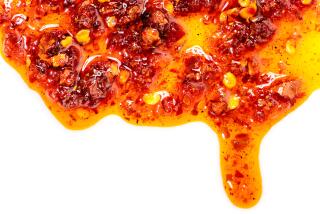The Heating of American Eating
- Share via
Hot, hot, hot. America is sizzling with a new dining addiction. Sauces, relishes--anything laced with hot chili peppers. The alkaloid capsaicin, which accounts for the heat in chili peppers (there are more than 200 varieties), has Americans breathing, and inhaling, fire.
Ah, the changing American palate. Dousing hot and spicy condiments on tepid foods of European origin was once confined to the Southwest and Louisiana (from which hails the oldest--1868--and best known red pepper sauce, Tabasco). Now high-spice condiments are flocking in from Mexico, the Caribbean, Thailand, Vietnam and India in a sort of global gasp attack.
Beware the simple phrase “ethnic cuisine,” for while spice in nice both on the palate and among the population, some varieties can be downright hostile. The prime example is Mexican salsa, no newcomer to the Southern California palate. In 1991, salsa sales surpassed catsup in the United States.
Now there are about 450 hot sauce labels in American markets and restaurants. Among them is the fiery red Tuong Ot brand sriracha (sree-rah-chah) relish, a traditional Southeast Asian sauce named after a seaside Thai town. Tuong Ot claims fans among the inmates at the California men’s prison at San Luis Obispo, where “packing heat” takes on new meaning.
Even A-1 Steak Sauce and the venerable Tabasco are offering spicier versions to keep up with the dramatic shift in American taste toward hot-hot over the past two decades. There are spice specialty stores, catalogs and magazines. Hot and spicy food shows are burning a path across the country. This bastion of meat and potatoes and pumpkin pie is under assault. Pass the sriracha, please, and maybe a couple of those heartburn pills.


